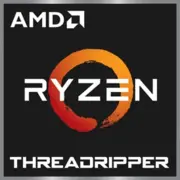AMD Ryzen Threadripper 1920X

AMD Ryzen Threadripper 1920X: A Guide to the HEDT Legend in 2025
Updated: April 2025
Introduction: Why is the Threadripper 1920X Still Relevant?
Even years after its release (2017), the AMD Ryzen Threadripper 1920X remains an iconic processor for enthusiasts. In 2025, it attracts attention for budget builds for workstations and upgrades for old systems. Let's explore if it’s worth considering today and who it suits best.
1. Key Specifications: Architecture and Performance
Whitehaven Architecture and 14nm Process
The Threadripper 1920X is built on the Zen microarchitecture (first generation) using a 14nm process from GlobalFoundries. Despite its age, 12 cores and 24 threads provide high potential for parallel tasks. Key features include:
- 32MB L3 Cache: Reduces latency when working with large data sets.
- TDP 180W: High power consumption requiring serious cooling solutions.
- 64 PCIe 3.0 lanes: Support for multiple GPUs and NVMe drives.
Performance in 2025
Geekbench 6 results (current as of 2025):
- Single-Core: 1171 — Comparable to Intel Core i7-7700K, which limits its usability in modern gaming.
- Multi-Core: 6854 — Comparable to Ryzen 5 7600X (6 cores), but lacks the energy efficiency of newer 12-core CPUs.
Key highlights:
- Unlocked multiplier for overclocking.
- Support for quad-channel DDR4 memory.
2. Compatible Motherboards
TR4 Socket and X399 Chipset
The processor uses the TR4 socket (Socket SP3r2), which is physically compatible with some motherboards for second-generation Threadripper, but requires a BIOS update. Recommended chipsets include:
- X399: The only option for the first generation Threadripper.
Popular models (2025):
- ASUS ROG Zenith Extreme — 8 DDR4 slots, 3x PCIe x16.
- MSI X399 Gaming Pro Carbon AC — Balances price and functionality.
Selection tips:
- Check support for 1920X in the compatibility list.
- Look for motherboards with active VRM cooling — the processor demands stable power.
3. Supported Memory
DDR4: Maximum 4 Channels
The Threadripper 1920X only works with DDR4:
- Frequencies: Officially up to 2666MHz, but overclocking to 3200MHz is possible.
- Configuration: 4 or 8 modules to activate quad-channel mode.
Recommendations:
- 4x8GB DDR4-3200 CL16 kits — optimal choice for price and performance balance.
- Avoid modules with high latency (CL18+).
4. Power Supply: Power Calculation
Minimum Requirements
With a TDP of 180W and using a high-end graphics card (e.g., RTX 4070 Ti):
- Recommended PSU: 750–850W with 80 Plus Gold certification.
- Examples: Corsair RM750x, Seasonic Focus GX-850.
Important:
- Power consumption can increase to 220–250W when overclocked.
- Use cables with dual 8-pin EPS connectors for the CPU.
5. Pros and Cons of the Threadripper 1920X
Advantages:
- Multi-threaded performance: 24 threads are effective for rendering and virtualization.
- Scalability: 64 PCIe 3.0 lanes for multiple devices.
- Second-hand market price: $150–250 (used) versus $500+ for a new 12-core CPU.
Disadvantages:
- Outdated process technology: 14nm vs. 5–7nm found in modern CPUs.
- No support for PCIe 4.0/5.0 and DDR5.
- High power consumption: Comparable to Ryzen 9 7900X (12 cores, 170W).
6. Use Cases
Work Tasks:
- 3D Rendering (Blender, V-Ray): 12 cores reduce render times.
- Video Editing (Premiere Pro): Threads speed up H.264/HEVC encoding.
- Virtualization: Run multiple VMs without slowdowns.
Gaming:
- Moderate performance: At Full HD (Cyberpunk 2077 — ~60 fps on medium settings with RTX 3060 Ti).
- Limitations: Low single-core rating is not suited for 144+ Hz.
Media:
- Streaming + gaming: 24 threads handle OBS and gaming simultaneously.
7. Comparison to Competitors
Intel Core i9-10920X (12 Cores):
- Intel’s advantage: Better single-core performance (+15%).
- Cons: More expensive in the second-hand market, fewer PCIe lanes (48).
AMD Ryzen 9 5900X (12 Cores):
- Zen 3 (7nm): +30% IPC, supports PCIe 4.0.
- Cons: No quad-channel memory.
8. Practical Assembly Tips
Cooling:
- Cooler: Noctua NH-U14S TR4-SP3 or Corsair H150i AIO (360mm).
- Thermal Paste: Arctic MX-6 or Thermal Grizzly Kryonaut.
Case:
- Choose models with good airflow (Lian Li Lancool III, Fractal Design Meshify 2).
Build:
- Ensure the cooler is compatible with TR4.
- Update the motherboard BIOS before installing the CPU.
9. Final Conclusion: Who is the Threadripper 1920X For?
This processor is worth considering in two cases:
1. Upgrade of an old X399 system: A cost-effective way to boost performance without replacing the motherboard.
2. Budget workstation: For rendering, editing, and virtualization, if there are no requirements for PCIe 4.0/5.0.
Avoid choosing the 1920X if:
- High FPS in gaming is essential.
- Energy efficiency is a priority.
Conclusion
The AMD Ryzen Threadripper 1920X in 2025 is a niche solution for those who value multi-threading and have access to compatible components. It lags behind new CPUs in speed but excels in price/performance ratio for specific tasks.
Basic
CPU Specifications
Memory Specifications
GPU Specifications
Miscellaneous
Benchmarks
Compared to Other CPU
Share in social media
Or Link To Us
<a href="https://cputronic.com/cpu/amd-ryzen-threadripper-1920x" target="_blank">AMD Ryzen Threadripper 1920X</a>